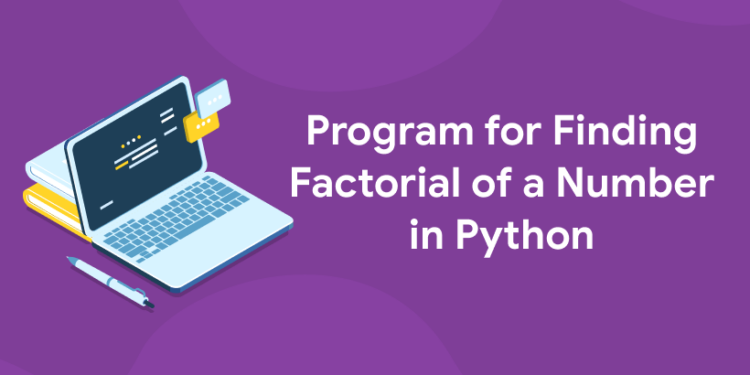Table of Contents
If you have never heard of the Python programming language, this article will give you an introduction to one of the most popular programming languages in the world. In particular, we’ll take a look at the implementation of factorials in Python and how to calculate them efficiently and accurately. If you’re learning Python, you’ve probably already run into the factorial operator (represented by the ! symbol). It calculates the product of all integers up to and including the number passed in as an argument to the function. The factorial of 6, for example, would be 6 * 5 * 4 * 3 * 2 * 1, or 720. In Python, you can use this operator in various functions that have been programmed to expect it as an argument. The algorithm for factorial of a number (sometimes called the gamma function) is the product of all the positive integers less than or equal to that number. For example, 4! (four factorial) = 4 x 3 x 2 x 1 = 24 and –6! = –6 x –5 x –4 x –3 x –2 x –1 = 720. The factorial of zero is defined as being one, which makes sense since 0! = 1. In this tutorial, you’ll learn how to write a Python program to find the factorial of any number entered by the user.
“Experience the power of our web development course with a free demo – enroll now!”
Python Program
This program to find factorial of a number entered by the user. We’ll be using a for loop to calculate the factorial. First, we’ll need to ask the user for input. Then, we’ll use a for loop to calculate the factorial. Finally, we’ll print out the result. We can also get this same result with a recursive function that is called recursively. The recursive function will stop calculating when it reaches 1 and return 1 as the answer (e.g., 5! = 120). If it is not yet at 1, then we will call it again with factorial of the previous answer * current value (e.g., 6! = 720).
First, we’ll need to define our recursive function and import Python’s math module so that we can use its pow() function: def find factorial(n):
This is our recursive function if n == 1: return 1 else: return n*findFactorial(n-1) Next, we’ll set up some values in order to run our recursive function. I’m setting my initial values as 3, 7, 11, and 15. We could just enter these values into the console like you would enter a command but I think it might be more helpful to see how they are calculated below: Next, we’ll iterate through these values in order to see what happens when they are all calculated via the recursive function and also when they are calculated with a for a loop. When I run each calculation I’ll print out Find Factorial Recursive or Find Factorial For Loop. Here is what happens with my calculations.
Factorial in Python
The algorithm for factorial of a number is the product of all the integers from 1 to that number. For example, the factorial of 4 is 4x3x2x1=24. The factorial of 0 is 1. To find a program to find factorial of a number, we can use a for loop. The code will look like this: factorial = 1
n = 5 ; while (n>0): factorial *= n; n-=(n-1); print(factorial) When I ran this program with the value of 10, it printed 3628800 as shown below. If you want to calculate other values of n, please use the comment and enter your own numbers. Remember that you have to press ENTER after every line! factorial = 1
n = 5 ; while (n>0): factorial *= n; n-=(n-1); print(factorial) When I ran this program with the value of 10, it printed 3628800 as shown below. If you want to calculate other values of n, please use the comment and enter your own numbers.
n = 9; while (n>0): factorial *= n; n-=(n-1); print(factorial) The code will look like this: if __name__ == ‘__main__’: main() Save the above code in a file named find_Factorial.py and run it by typing python find_Factorial.py in an interactive python shell or save it as find_Factorial.py and execute it on IDLE or another IDE of your choice by just double clicking on that file name in Windows Explorer/Nautilus File Manager.
“Experience the power of our web development course with a free demo – enroll now!”
Factorial program in Python
A Factorial of a Non-Negative Integer is when you multiply all the integers less than or equal to that number together. For instance, if we want to find out the Factorial for 6 it would be 6 * 5 * 4 * 3 * 2 * 1, which equals 720!
Using built-in function
Math modules provide the built-in function called factorial, used for calculating an integer raised to a positive integral power. Here are some examples of how it works.
Example –
- # Python program to find
- # factorial of a given number
- import math
- def fact(n):
- return(math.factorial(n))
- num = int(input(“Enter the number:”))
- f = fact(num)
- print(“Factorial of”, num, “is”, f)
Output:
Enter the number: 6 Factorial of 6 is 720
We have made imported the math module which contains a built-in functionality for calculating factorials. There is no need to make it with logic because we can just input an integer into it and get our desired result.
Import Math Module
The factorial of a number is the product of all the integers from 1 to that number. For example, the factorial of 4 is 1*2*3*4=24.
The factorial of 0 is 1.
The math module has a function called factorial() that takes a single argument and returns the factorial of that number. Here’s an example: factorial(5) = 5*4*3*2*1 = 120
factorial(-1) = 1 ; factorial(0) = 1;
factorial(-100) = 100! /(-100)! = -352879200000000000000♠5.6290e+29
factorial(-200) = 200!/(-200)! = -146696480000000000000♠-12
You can use factorials in expressions. For example, (-1)! is equivalent to 1, and 10! divided by 4! is equivalent to 2.5 (10/4=2.5). The factorial operator has some interesting mathematical properties; it’s never negative and it’s always nonzero even when its argument is zero. It also increases without bound as n approaches infinity. As with other functions in Python, you can type help(factorial) into the Python interpreter for more information about how to use this function or read about it on Wikipedia.
Although there are many different programming languages out there—all with their own specific features—there are some common elements across most languages used today. One feature that is present in almost every language is branching statements. A branching statement tells the computer to take one path or another based on some condition being met. These statements typically come in two forms: conditional statements and loops. A conditional statement evaluates whether or not a certain condition is true before deciding which branch to take, while a loop repeats an action until some condition becomes false. Conditional statements and loops work together nicely because loops allow you to perform repetitive tasks easily without having to write lots of extra code, while conditional statements allow you to make decisions based on data inputted by the user and changes in environment variables outside of your control.
“Get hands-on with our python course – sign up for a free demo!”
Conclusion
In this blog post, we learned how to write a Python program to find the factorial of a number. We first looked at what a factorial is and how it can be calculated. We then looked at how to write a Python program to calculate the factorial of a number. Finally, we ran our program and verified that it worked correctly. Our code performed just as expected, so we are confident in its accuracy. If you are interested to learn new coding skills, the Entri app will help you to acquire them very easily. Entri app is following a structural study plan so that the students can learn very easily. If you don’t have a coding background, it won’t be a problem. You can download the Entri app from the google play store and enroll in your favorite course.











